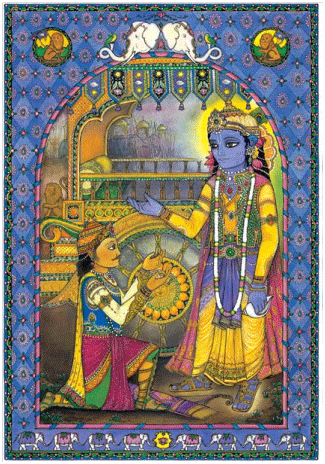 |
23 REASONS TO LOVE THE BHAGAVAD GITA
What's behind my 25-year love affair with what is often called India's greatest gift to humanity?
By Jack Hawley 
I am Pure Consciousness, the underlying essence of all elements and beings.
I am the innate nature of everything.
In pure water I am the sweet taste.
In the sun and moon I am the radiance.
In the very center of human beings I live as virility and courage.
I am the sacred word Om, which is an appellation of the Divine,
and I am the sound of it heard throughout the universe.
I am the slight, delicate scent, the sweet fragrance of the earth.
I am the brilliance in both fire and sun, and I am the light of Divinity in all beings.
I am the subtle spirit in spiritual practices that gives them their
existence — for example, the love in the devotee, the austerity
in the ascetic, the sweet sense of charity in the giver.
It continues for several more chapters, but by this time we had fallen from head to toe in love with this wondrous text. We were beginning to understand why this half-inch-thick masterpiece poem about life, death, love, and duty is often called India’s greatest gift to humanity.
8,000 years ago people embarked on a startlingly different approach to learning, turning inward. The origins of the Gita go back as many as 8,000 years, when the people who were building sophisticated cultures here inthe river valleys embarked on a startlingly different approach to learning. As they tried to comprehend their world — which was no doubt as vexing to them as our world is to us — they discovered important new ways of understanding. Instead of looking outward for their answers, a small number of these earliest scientists turned inward.
Thus, humanity began, those eons ago, to methodically explore consciousness. The methods they developed were not for merely coping with a harsh world but for living at a rare level of consciousness that includes almost uninterrupted happiness. Birthed back then were the principles of atma (a version of “soul”), reincarnation, dharma, karma, meditation, and serenity. These are the ideas that parented Hinduism, Buddhism, Jainism, Taoism, and influenced most other enlightenment systems.
The Bhagavad Gita (the “Song Celestial”) is the most complete spiritual text from those times. The Gita — buried in the center of a six-inch-thick epic masterpiece poem, the Mahabharata (“Great Country”), about the heights and depths of the human soul — gives us a continuous, unbroken sight line back into the minds and hearts of men and women living in those primeval times. It provides perhaps the most complete explanation of the earliest spiritual formulations of humanity, and it lives on today as a still-fresh centerpiece text guiding thedaily lives of hundreds of millions of human souls.
Now, in my small room a generation later, having researched and written four books about the Gita, I wonder how best to express the real meaning of this great work. The only true way to let people in on the essence of the Gita’s spiritual gifts is to not try to analyse or further codify it; talking about the epic does not convey its epic deepness. Instead, the ancient sages within me whisper the answer: “Share your love.”

The Bhagavad Gita begins with an impending war. Grief-stricken at the prospect of battling armies of teachers, relatives, and friends, the warrior Arjuna refuses to fight. The God Vishnu, incarnated as the charioteer Krishna, tells Arjuna he must fulfill his destiny as a warrior (right): the soul is indestructible and Arjuna must fight without attachment or aversion to an outcome.
I love the Gita’s basic goodness, and how it pushes me beyond merely trying to be a good person toward becoming my own Divinity within. And I love that it provides me with page after page of the means to call forth that extreme goodness in me. And I love how it continually reminds me to do that.
I love the ultra-honesty in it about religion and the notions of heaven and hell, death and life. I love how the Gita lives in the open spaces beyond religious dogma, and yet has a reverence for the scriptural teachings of all faiths.
I love the Gita’s absolute insistence on truth, and how adamant it is that we follow our own basic nature and live a dharmic life — which is to consciously live by our own inner truth, a whole life of doing the right thing. I love how it doesn’t compromise an iota on this, and won’t take any excuses where truth is concerned.
I love how the Gita is so clear about how we must live with the consequences of our actions, but with no hint of punishment. I love how it neither excuses nor overlooks our dark side — and yet doesn’t dwell there, highlighting instead the bright side of humanity. Indeed, Sanskrit, the precise spiritual language of the Gita, has no word for damnation.
I love my own inner peacefulness whenever I enter the Gita’s teachings. I love how my anger has pretty much been eliminated, and how worldly agitations are largely things of the past for me.
I love the Gita’s teachings on acceptance — not mere compliance, but acceptance as a state of mind and way of being — a receptiveness so elevated that one’s life forever soars when touched by the magic of it. This acceptance is the most shining facet of love, so all-embracing it’s the very essence of spiritual surrender. When my wife suffered a stroke in India, we were both imbued with such a strong mood of acceptance that we are convinced that being in this mental zone is what pulled her through. (That full story is retold in The Bhagavad Gita: A Walkthrough for Westerners [New World Library, 2001].)
I just love the happiness in the Gita, and thoroughly appreciate its careful explanation of how to attain real happiness. I appreciate also that it lays out what happiness is not, and is so clear about the obstacles in the way of lasting happiness.
I love its definition of sin — not evil acts, but actions that make us veer from the spiritual path, away from our own Divine nature.
I love that the Gita’s truths, though stated in different ways at different times by different peoples of the world, have been known to humanity for millennia — and that all higher religions and philosophical systems are in nearly complete agreement with these basic truths.
I love the fact that the utter truths of the Gita have been tested and purified down through so many centuries. It makes me feel humbled and gladdened that these hoary ideas, stemming from perhaps one of the oldest records of humanity (the Vedas), precede all other teachings known in the world today; that they have passed the severe tests of countless centuries.
I also love that it so carefully explains just what heaven and hell are, and what they are not. And I love that the Gita reminds me that I can create heaven here on earth, if I want.
I love not only its straightforward elucidation of what God really is, but also what I really am. Something shivers deep inside because these two descriptions sound so much alike.
I love that it teaches us to return love for hate.
I love the absolute love in the Gita, and the utter adoration that saturates its pages. I love its straightforward emphasis on experiencing devotion to a loving God.
I love its insistence that we love everyone. No exceptions allowed!
I love that the Divinity described in the Gita is loving, gentle, and nonpunitive.
I love that the Gita explains with precision how the world really works and how my life really works — and how I can live a truly happy life and even die happy.
I love the Gita’s far-out, far-reaching audaciousness — insisting, in the face of today’s universal convictions to the contrary, that human suffering can be overcome. (It’s a matter of moving beyond mere happiness.)
I love how the Gita looks death (and life) squarely in the eye, and gives not only straightforward methods for conquering our fears of death, but for triumphing over death itself! (The secret: move beyond the painful cycle of birth and death altogether.)
I love the emphasis in the Gita on going beyond — beyond all our worldly levels of understanding, beyond everything we see or feel in the world. I love that it pulls us higher and higher to our most lofty nature — and then even beyond that, as I mentioned, to the Divinity within us. I love how it shows me again and again that I am all the power and glory of the universe, and so is everyone.
I love the Gita’s emphasis on application, its insistence that we put its teachings into practice in our daily lives. “Theory and make-believe have no place in true spirituality,” says the Gita.
I love the Gita because it explains the significance of the mystical declaration “Om-Tat- Sat.” Pronounced “Om-tut-sut,” this ancient phrase is said to echo back to the very beginning of time when Divinity first projected itself as sound. Each word represents Supreme Consciousness, the Source from which everything else comes. Uttered by knowledgeable people whenever they perform spiritual activities, Om-Tat-Sat lends a blessed and sacred tone to their actions, serving as a reminder that the act about to be done is noble and conducive to self-realization. Invoking this declaration, the sages tell us, purifies one’s own acts and reforms the world as well.
I love the Gita for its depth, breadth, and mostly its height. I love it for its honesty and humanness, for its gentleness and its loving devotion. I love how it makes room for everybody. I love how it tells it all so straight.
Jack Hawley, Ph.D., lives, studies, and lectures half of each year in an ashram in rural southern India, where the values of the Gita are very much alive. When not in India, he brings these ancient yet current ideas to leaders and organizations in the West. His books include the classic Bhagavad Gita: a Walkthrough for Westerners; Reawakening the Spirit in Work: the Power of Dharmic Management; Roadmaps to Self- Realization; and Essential Wisdom of the Bhagavad Gita. His website is GitaWalkthrough.com; email is jackhawley@yahoo.com. Kim Waters Murray is co-author and illustrator of Illuminations from the Bhagavad Gita and The Butter Thief (from Mandala Publishing, mandala.org).
Courtesy - http://www.geetarahasya.com/
|
 |